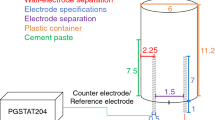Abstract
Freezing and thawing properties of cement paste were studied using an alternating current impedance spectroscopy (ACIS) technique coupled with the thermomechanical analysis (TMA). The measurements from the ACIS were analyzed in association with the length change of the cement paste determined by TMA. The micro-scale behavior of cement paste observed by the ACIS technique was well correlated with the residual expansion of cement paste after the freezing and thawing cycle. The efficacy of the ACIS technique for assessing the durability of cement paste to frost action was confirmed.










Similar content being viewed by others
References
Bager DH, Sellevold EJ (1986) Ice formation in hardened cement paste—Part I: Room temperature cured pastes with variable moisture contents. Cem Concr Res 16:709–720
Christensen BJ, Coverdale RT, Olson RA, Ford SJ, Garboczi EJ, Jennings HM, Mason TO (1994) Impedance spectroscopy of hydrating cement-based materials: measurement, interpretation, and application. J Am Ceram Soc 77(11):2789–2804
Helmuth RA (1960) Capillary size restrictions on ice formation in hardened Portland cement paste. In: Fourth international symposium on the chemistry of cement, Washington, DC, USA, pp 855–869
Litvan GG (1972) Phase transitions of adsorbates: IV. Mechanism of frost action in hardened cement paste. J Am Ceram Soc 55(1):38–42
McCarter WJ, Brousseau R (1990) The A.C. response of hardened cement paste. Cem Concr Res 20:891–900
McCarter WJ, Garvin S, Bouzid N (1988) Impedance measurements on cement paste. J Mater Sci Lett 7:1056–1057
Macphee DE, Sinclair DC, Cormack SL (1997) Development of an equivalent circuit model for cement pastes from microstructural considerations. J Am Ceram Soc 80(11):2876–2884
Olson RA, Christensen BJ, Coverdale RT, Ford SJ, Moss GM, Jennings HM, Masonand TO, Garboczi EJ (1995) Interpretation of the impedance spectroscopy of cement paste via computer modeling. J Mater Sci 30(20):5078–5086
Perron S, Beaudoin JJ (2002) Freezing of water in Portland cement paste—an AC impedance spectroscopy study. Cem Concr Compos 24:467–475
Powers TC, Helmuth RA (1953) Theory of volume changes in hardened Portland cement paste during freezing. Mater Constr 46:285–297
Sato T, Beaudoin JJ (2003) An AC impedence spectroscopy study of freezing phenomena in wollastonite micro-fiber reinforced cement paste. In: Proceedings of the international symposium on role of cement science in sustainable development, Scotland, UK, Sep 3–4, pp 379–388
Setzer MJ (1997) Action of frost and deicing chemicals: basic phenomena and testing. In: Marchand J, Pigeon M, Setzer M (eds) Freeze-thaw durability of concrete. E & FN Spon, London, pp 3–22
Xie P, Gu P, Xu Z, Beaudoin JJ (1993) A rationalized A.C. impedance model for microstructural characterization of hydrating cement systems. Cem Concr Res 23:359–367
Author information
Authors and Affiliations
Corresponding author
Rights and permissions
About this article
Cite this article
Sato, T., Beaudoin, J.J. Coupled AC impedance and thermomechanical analysis of freezing phenomena in cement paste. Mater Struct 44, 405–414 (2011). https://doi.org/10.1617/s11527-010-9635-3
Received:
Accepted:
Published:
Issue Date:
DOI: https://doi.org/10.1617/s11527-010-9635-3



